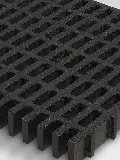loading...
- No. 9, Xingyuan South Street, Dongwaihuan Road, Zaoqiang County, Hengshui, Hebei, China
- admin@zjcomposites.com
- +86 15097380338
- Welcome to visit our website!
Exploring the Benefits of FRP Square Pipes in Various Applications
Understanding FRP Square Pipes Applications and Benefits
Fiber Reinforced Plastic (FRP) square pipes are gaining significant attention across various industries due to their unique properties and versatile applications. These pipes, made from a combination of fiberglass and resin, provide a lightweight yet strong alternative to traditional materials like steel and PVC. In this article, we will explore the advantages of FRP square pipes, their applications, and the factors contributing to their growing popularity.
What is FRP?
FRP, or Fiber Reinforced Plastic, is a composite material composed of a polymer matrix reinforced with fibers, usually glass, carbon, or aramid. The inclusion of these fibers enhances the mechanical properties of the plastic, making it stronger and more durable. FRP is known for its resistance to corrosion, which makes it ideal for use in harsh environments.
Key Advantages of FRP Square Pipes
1. Corrosion Resistance One of the most significant benefits of FRP square pipes is their excellent resistance to corrosion and chemical damage. Unlike traditional metal pipes that are prone to rust and degradation, FRP pipes can withstand exposure to a wide range of chemicals, making them suitable for use in chemical processing, wastewater treatment, and marine applications.
2. Lightweight FRP square pipes are considerably lighter than their steel counterparts. This reduces the overall weight of the structures they are used in, leading to easier handling and installation. The reduced weight also translates to lower transportation costs and energy savings during installation.
3. High Strength-to-Weight Ratio Despite being lightweight, FRP square pipes offer impressive strength and durability. Their high strength-to-weight ratio makes them a reliable choice for various structural applications. They can bear heavy loads without compromising their integrity.
4. Thermal and Electrical Insulation FRP pipes provide excellent thermal and electrical insulation properties. This makes them suitable for applications where temperature fluctuation is a concern or where electrical conductivity must be minimized.
5. Low Maintenance Due to their resistance to corrosion and wear, FRP square pipes require very little maintenance, which can lead to significant cost savings over their lifespan. This aspect is particularly appealing for industries operating in demanding environments.
frp square pipe

Applications of FRP Square Pipes
The applications of FRP square pipes are vast and varied. Here are some notable examples
- Construction and Infrastructure FRP square pipes are increasingly used in building structures, bridges, and roads, providing a lightweight yet strong solution for various engineering projects.
- Chemical Industry In chemical processing plants, these pipes are utilized for transporting corrosive substances without the risk of degradation, ensuring safety and compliance with regulations.
- Water and Wastewater Treatment Given their resistance to corrosion, FRP pipes are widely utilized in water treatment facilities, helping to convey and process water and wastewater effectively.
- Marine Applications The maritime industry benefits from FRP square pipes due to their resistance to saltwater corrosion and buoyancy, making them ideal for docks, piers, and offshore platforms.
- Telecommunications FRP is also used in the production of conduits and cable trays, protecting sensitive electrical wiring from environmental damage.
Conclusion
In conclusion, FRP square pipes offer an array of attributes that make them suitable for a variety of applications across multiple industries. Their corrosion resistance, lightweight structure, and low maintenance requirements position them as an excellent alternative to traditional materials. As industries continue to seek innovative solutions, the adoption of FRP square pipes is poised to grow, contributing to efficiency and sustainability in infrastructures worldwide. With their numerous benefits and diverse applications, FRP square pipes represent a significant advancement in the field of materials engineering.
-
Transform Your Spaces with FRP Grating SolutionsNewsNov.04,2024
-
The Versatility and Strength of FRP RodsNewsNov.04,2024
-
The Excellence of Fiberglass Water TanksNewsNov.04,2024
-
The Benefits of FRP Grating for Your ProjectsNewsNov.04,2024
-
Elevate Your Efficiency with FRP Pressure VesselsNewsNov.04,2024
-
Welcome to the World of FRP Pressure VesselsNewsOct.12,2024
-
Unveiling the Future of Filtration: Why FRP Filter Vessels are a Game ChangerNewsOct.12,2024
